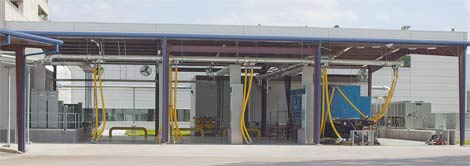
This HP PODbase facility in Houston is where the company commissions its Performance Optimized Datacenter (POD) units prior to customer deployments.
Language matters. And when it comes to large investments in IT equipment, subtle changes in technology and terminology can make a difference.
That's reflected in the current shift in how IT vendors are talking about modular designs. Many of the concepts have evolved from the development of data center containers. But don't call them containers.
"What we offer today is not a container. That is so 24 hours ago," said HP's Ken Baker. "We now do purpose-built frames."
Baker's comment reflects the advances in design at HP and other companies focused on modular deployment. But it also speaks to the growing sentiment that early resistance to containers may have been rooted in the form factor, and that more refined designs could boost adoption of factory-built data center components.
Containers "Not the Right Vehicle"
"We learned real quickly that shipping containers were not the right vehicle for this," said Colin Coyle of HP Critical Facilities Services, who along with Baker discussed HP's modular approach at last week's DataCenterDynamics event in Washington, D.C. "Industrialization is more of a mantra for us now."
For HP, that led to the Flexible Data Center, which features factory-built modules that support quick deployment and phased growth of enterprise infrastructure. The product's "butterfly" design - featuring a center core module for networking and security, surrounded by four modular server rooms - resembles a traditional data center more than a container.
"Containers are an interesting idea," said Baker. "Everyone began by going out and buying ISO containers. And we did that, too. But things have evolved significantly from there. Things are moving very, very quickly in this space."
While HP has introduced its Flexible Data Center, it continues to refine the Performance Optimized Datacenter (POD), its original container offering. "We're now in our fourth generation design for the POD," said Baker.
Air-Cooled POD Coming
Towards that end, HP will soon introduce an air-cooled container. The PODs currently use chilled water for cooling. "We're within a month or so of bringing to market an air cooled POD product," Baker said. The air-cooled design can use back to back containers venting to the outside into an exterior hot aisle.
Baker said the shift from ISO containers to frame-built designs also allows HP to put different types of skins on the outside of the module. "We're building pods for government agencies that are EMI resistant, and bullet resistant,” said Baker.
Custom construction also allows HP to make heavier PODs. A 40-foot POD can now handle total weight loads of up to 111,000 poinds - nearly 56 tons. A standard equipment-filled ISO container typically might run 60,000 pounds.
Issues With Weight Limits
That type of scale may not work everywhere, as it's likely to test the weight limits of highways and bridges, many of which have weight limits of 80,000 pounds. It turns out that transportation issues in delivering PODs were a factor in HP's introduction of a 20-foot version earlier this year. Baker said the 20-foot version can be delivered to venues in Europe where a 40-foot POD might present transportation issues.
At the DataCenterDynamics conference, Baker also provided a look at the Houston facility where HP tests and commissions its POD products prior to delivery. At first glance the "PODbase" resembles a gas station, with a roof and series of hookups for the PODs. The facility is supported by 3 megawatts of power capacity, and can accommodate up to seven containers at a time.
"This is really the tool that makes this business work for us," said Baker, who ecpects to see many more PODs rolling through the facility. "We've committed ourselves to this market."

This Houston facility is where HP commissions its Performance Optimized Datacenters prior to customer delivery.




